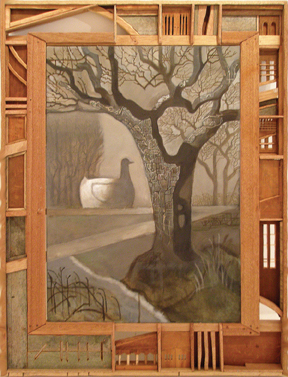Art Commentary: Kustura, Suter and Waller at Pamela Williams Gallery

Amagansett’s Pamela Williams Gallery has opened its season with a bang, and if that sounds like hype, it’s not meant to be. The artists in the exhibit are always provocative, colorful and ambiguous, all qualities that add fuel to our artistic tastes. Moreover, the works are hung in such a way that stimulates our senses and intellect as well.
There’s always been an aesthetic connection between Charles Waller and David Suter, primarily because you never know quite what to expect. Even so, their use of materials and found objects is predictably charming and whimsical, their underlining meanings substantial and even philosophical. [expand]
Waller’s “Victory Garden” is a case in point. Employing real seed packets, which are attached to drawings of roots and vines, there’s a suggestion that the vegetables are in transition as they hopefully evolve from seedlings to fully grown. Conversely, a nearby work called “Nest Egg” features a hand holding an egg. The object is labeled “Monster.” We wonder if this is a different interpretation of evolution (an egg often represents birth). Here’s where Waller’s ambiguity takes hold. This evolution theory may not be what the artist intended, yet it seems to fit with certain personal aspects of Waller’s life.
Found objects, like stamps and vintage labels, are also present in other pieces. His signature arrangement of postage stamps, juxtaposed with an ear, is found in “Secret 1,” perhaps suggesting that communication is “hearing” as well as writing. Waller’s penchant for shapes, no matter what the subject or meaning, is not only striking but also mind-bending.
We can also say the same about Suter’s forms and materials. For instance, while his “Ducky” (featuring the famous Flanders duck) is seemingly simple and subtle, the woodcarvings forming the work’s frame are elaborate. Such carvings recall tree branches, which are present in other pieces. Suter’s use of wood in his small sculptures is also a motif, his animal subjects (“Third Horse” and “Wolf Man”) assuming unique personalities. There’s an odd sense that the animals are communicating with each other or the viewer.
It appears that Suter has another perspective on communication in “Lost.” Perhaps his most provocative sculpture in the show, it evokes the adage that “nothing is as it appears.” While the piece features a rescue boat suspended mid-air, there’s a mirror in the configuration that’s about as mysterious as you can get: looking into the mirror reveals a man made of wood staring back. Is Suter saying the viewer must communicate with himself, that this is the truest form of rescue? Then again, maybe we are reading too much into this work.
Ivan Kustura’s paintings are equally mysterious, blending Expressionism and Surrealism as a hybrid style. Unlike Waller’s and Suter’s works, Kustura mostly celebrates the female figure, recalling hard-edged graphic art. The artist’s themes are just as intriguing, namely fragmentation of body parts (recalling Surrealism). Is this a comment on women’s lack of wholeness or society’s perspective about what the gender has become?
These identification issues are also present in another piece where a female is looking at a large picture (perhaps of herself) in the background. Is she questioning who she is? This same meaning may be reinforced in one work where a nude’s face is defocused, her features (and identity) unclear. Whatever Kustura’s intention, his images are food for thought.
The exhibit at Pamela Williams Gallery will be on view until July 4 at 167 Main Street, Amagansett. Call 631-267-7817 for information. [expand]



